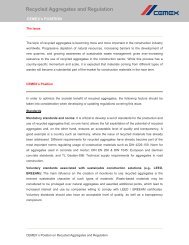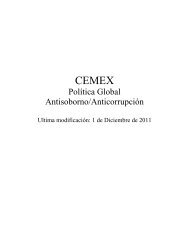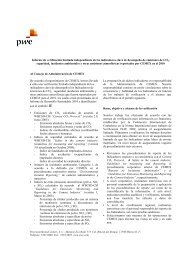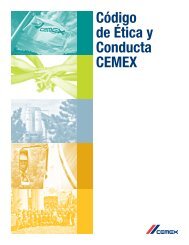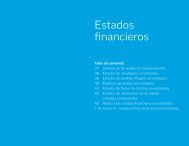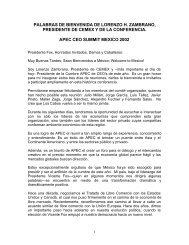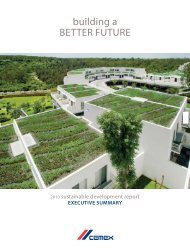building a STRONGER foundation - Cemex
building a STRONGER foundation - Cemex
building a STRONGER foundation - Cemex
Create successful ePaper yourself
Turn your PDF publications into a flip-book with our unique Google optimized e-Paper software.
CEMEX, S.A.B. DE C.V. AND SUBSIDIARIES<br />
Notes to the Consolidated Financial Statements – (Continued)<br />
As of December 31, 2010, 2009 and 2008<br />
(Millions of Mexican pesos)<br />
Items of “Other equity reserves” not included in comprehensive income for the period:<br />
Effects related to controlling stockholders’ equity for changes or transactions affecting non-controlling interest stockholders in<br />
CEMEX’s consolidated subsidiaries;<br />
Effects attributable to controlling stockholders’ equity for financial instruments issued by consolidated subsidiaries that qualify for<br />
accounting purposes as equity instruments, such as the interest expense paid on perpetual debentures;<br />
The component of equity of outstanding mandatorily convertible securities into shares of the Parent Company (note 12A). Upon<br />
conversion, this amount will be reclassified to common stock and additional paid-in capital;<br />
The component of equity of the optional convertible subordinated notes into shares of the Parent Company (note 12A). If the conversion<br />
option is exercised, this amount would be reclassified to additional paid-in capital; and<br />
The cancellation of the Parent Company’s shares held by consolidated subsidiaries.<br />
Retained earnings (note 16C)<br />
Retained earnings represent the cumulative net results of prior accounting periods, net of dividends declared to stockholders, and net of any<br />
recapitalizations of retained earnings. Retained earnings also include the effects from the adoption of certain newly issued MFRS as detailed<br />
in note 16C.<br />
Non-controlling interest and perpetual debentures (note 16D)<br />
This caption includes the share of non-controlling stockholders in the results and equity of consolidated subsidiaries. This caption also<br />
includes the amount as of the balance sheet date of financial instruments (perpetual notes) issued by consolidated entities that qualify as<br />
equity instruments because there is: a) no contractual obligation to deliver cash or another financial asset; b) no predefined maturity date; and<br />
c) an unilateral option to defer interest payments or preferred dividends for indeterminate periods.<br />
P) REVENUE RECOGNITION<br />
CEMEX’s consolidated revenues represent the value, before tax on sales, of products and services sold by consolidated subsidiaries as a<br />
result of ordinary activities, after the elimination of transactions between related parties. Revenues are quantified at the fair value of the<br />
consideration received or receivable, decreased by any trade discounts or volume rebates granted to customers.<br />
Revenue from the sale of goods and services is recognized when goods are delivered or services are rendered to customers, there is no<br />
condition or uncertainty implying a reversal thereof, and the customers have assumed the risk of loss. Revenues from trading activities, in<br />
which CEMEX acquires finished goods from a third-party and subsequently sells the goods to another third-party, are recognized on a gross<br />
basis, considering that CEMEX assumes the total risk of property on the goods purchased, not acting as agent or commissioner.<br />
Revenues and costs associated with construction contracts are recognized in the period in which the work is performed by reference to the<br />
stage of completion of the contract activity at the end of the period, considering that the following have been defined: a) each party’s<br />
enforceable rights regarding the asset to be constructed; b) the consideration to be exchanged; c) the manner and terms of settlement; d) actual<br />
cost incurred and contract costs required to complete the asset are effectively controlled; and e) it is probable that the economic benefits<br />
associated with the contract will flow to the entity.<br />
Q) COST OF SALES, ADMINISTRATIVE AND SELLING EXPENSES AND DISTRIBUTION EXPENSES<br />
Cost of sales represents the production cost of inventories at the moment of sale. Such cost of sales includes depreciation, amortization and<br />
depletion of assets involved in production and expenses related to storage in producing plants. Cost of sales excludes expenses related to<br />
personnel, equipment and services involved in sale activities and storage of product at points of sales, as well as costs related to warehousing<br />
of products at the selling points.<br />
Expenses related to freight of raw material in plants, as well as of finished product between plants and points of sale and freight expenses<br />
between points of sales and customers’ facilities, are all recognized within distribution expenses.<br />
For the years ended December 31, 2010, 2009 and 2008, selling expenses amounted to Ps7,894, Ps9,310 and Ps11,079, respectively.<br />
Distribution expenses refer to freight of finished products between points of sale and the customers’ facilities.<br />
R) MONETARY POSITION RESULT<br />
Monetary position result represents the gain or loss for holding monetary assets and liabilities in high-inflation environments and is calculated<br />
applying the inflation rate of the country where the subsidiary operates to its net monetary position (monetary assets less monetary liabilities).<br />
F-16



